![[The Ohio River Speaks] Headwaters: The Journey Begins](https://dgrnewsservice.org/wp-content/uploads/sites/18/2020/06/Headwaters-The-Journey-Begins.jpg)
by DGR News Service | Jun 10, 2020 | Listening to the Land
Originally named Ohi:yo’—“beautiful river”—by the Seneca, the Ohio River is now the United States’ most polluted river. The dominant culture teaches us to view natural beings like the Ohio River as objects to be used, consumed, and destroyed for human benefit.
This is a primary reason the destruction of the natural world is intensifying. How would our relationship to the natural world change if, instead of viewing nonhumans as objects, we viewed them as living beings capable of speaking to us? As allies who desire to communicate valuable lessons to us?
Where Does a River Begin?
By Will Falk / The Ohio River Speaks
This journey – like the Ohio River – has many beginnings. A river’s physical beginnings are often called headwaters. Water wells up from the ground or falls from the sky. Then, aided by gravity, water navigates the specific peculiarities of the land to collect and form the first wet trails distinct enough to earn names such as creek, brook, or stream. These creeks, brooks, and streams tirelessly search for each other, perpetually seek communion with their kin. And, when enough of them join together, they become rivers.
Where should we say a river begins? Which of those first passages of water in the round Pennsylvania hills or the thickly-wooded West Virginia mountains, which of those first liquid motions over white Indiana limestone or black Kentucky coal can we name as the beginning of the Ohio River?
Many mapmakers seem determined to pinpoint precise headwaters for the world’s rivers. This is strange because the idea that a river has only one starting point is belied by the very maps declaring this to be true. Google Maps has grown to be one of the most widely used maps in the world today. When I look at Google’s map of the Ohio River basin, I am told that the Ohio River begins at the confluence of the Allegheny and Monongahela rivers in Pittsburgh, PA.
Tracing the River’s Veins
But, if I follow the thin ribbons of blue twisting and curling across the map to their disappearance on the page, I am taken to dozens of different places. I trace the thin blue line representing the Allegheny River to the hills of Potter County in northern Pennsylvania. I trace the line representing the Monongahela River south of Pittsburgh and the line quickly splits in two. The map continues to label the western line “Monongahela,” but the eastern line is labeled “Youghiogheny River.”
I follow the eastern line up into the mountains near Aurora, West Virginia where it disappears. I go back to the line representing the Monongahela but it splits in two once more at Point Marion, Pennsylvania. The western line once again remains “Monongahela” and the eastern line reads “Cheat River.” Following the eastern line south, the Cheat River splits in two, one “Shavers Fork” and another “Black Fork.” The “Black Fork” line is joined by a line labeled “Blackwater River” which then splits into three lines named the “Dry,” “Glady,” and “Laurel” forks. These three lines then disappear in the hills of West Virginia near the Virginia state line.
Tracing each of the Ohio’s tributaries’ tributaries’ tributaries would take a long time. At the very least, we should understand that arbitrarily locating the headwaters of the Ohio River at the confluence of the Allegheny and Monongahela rivers in Pittsburgh is inaccurate, at best, and downright dishonest, at worst. So, why are geographers, topographers, and cartographers so determined to name a river’s headwaters? Is this a peculiar side effect accompanying the choice to don the suffix “-ographer.” Or, more likely, is it a symptom of the colonial impulse to control, to define, to destroy ambiguity, to produce one true answer as there is one true ideology, one true religion, one true God.
Stories Are Rivers and Rivers, Stories.
The Ohio River is not so much concerned with either accuracy or honesty as she is concerned with creativity –the land she shapes, the communities she forms, the songs she sings, and the lives she makes possible. Metaphor is a creative channel. It is a way of knowing far older than science or philosophy. I suspect that metaphor is a way of knowing far older even than logic. The Ohio River beckons me to swim in the channels of metaphor.
Stories, of course, are rivers and rivers, stories. The story of my journey with the Ohio River has many headwaters. These headwaters will flow into streams of written consciousness, lyrical vignettes, and fluid reflections. Like water, they will seek their kin who share thematic similarities and topical currents. The strongest writing, achieving a certain depth, will collect in pools as essays and chapters. One day, I hope, these stories may join together to form a book worthy of the Ohio River.
As I begin this journey, I feel the headwaters of many stories gathering within me. They well up from my lifelong love affair with oceans, lakes, rivers, and marshes; with fish, turtles, toads, and tortoises; with ripples, tides, waves, and the way crescent moons are best seen from a still pond face; with the infinite voices water sings with; with all water creates and all the lives water facilitates.
Blood and Water
My experiences as a practicing rights of Nature attorney and my work to stir bravery in the souls of those who love Nature begin gathering as another headwaters. I feel the waters in my body boiling for the respect they deserve. My heartbeat pounds, insisting on the sacredness of the water in the blood my heart works so consistently to move. My organs agitate against the poisons they must filter out of my daily drinking water.
I find the trickle of yet more stories in my family history. I recall how, in Evansville, IN on the banks of the Ohio River, my grandmother was prevented from being a Poor Clare nun. And how, if this didn’t happen, I would never have been born some 30-odd years later in Evansville not far from the Poor Clare convent. I hear the metaphors growing in clarity. The other sisters feared my granny was too talkative to take a vow of silence. Fortunately, my granny’s signature chattiness, her need to gossip and share stories, are properly understood as a beginning of my life’s story.
Current events are natural springs of stories. As much as I wish I could bury some of those springs, plug the wells, I can’t. I can’t ignore the images of black people being murdered in the streets for having the simple audacity to walk those streets. I can’t deny the scenes of indigenous people being teargassed on their own land for having the simple audacity to protect water. I can’t forget the reality that the natural world is being polluted, clear cut, dammed, consumed, and driven to extinction for having the simple audacity to exist. Thunder clouds and lightning appear on my inner horizon. These are the dark stories. The stories of mental illness, psychiatric hospitals, and court-ordered involuntary commitments. I need the rain, but I fear the acid that may fall with the guilt and shame. I fear the floods. I fear where those floods may carry me.
Rivers and Stories: More than One Beginning
Just like the Ohio River, it would take far too long to trace these stories’ tributaries’ tributaries’ tributaries. It is enough to say this:
No river has only one beginning. No story has only one beginning, either. But, writing is linear and sooner or later, but before the story is heard by a listener or read by a reader, the story teller must locate all of the story’s headwaters and direct her audience’s attention to one beginning. I will need some time to decide where that will be.
Give me a few days, and I’ll be back with my decision.
Will Falk is the author of How Dams Fall: On Representing the Colorado River in the First-Ever American Lawsuit Seeking Rights for a Major Ecosystem and a practicing rights of Nature attorney. Rights of Nature advocates work to transform the legal system so that it recognizes the “personhood” of natural beings. For the rest of 2020, Falk will travel through the Ohio River Basin asking the Ohio River the two questions he asks any client who steps into his office: “Who are you?” And, “What do you need?”
Featured image: Not far from the Ohio River’s true headwaters in Potter County, PA. Photo by Melissa Troutman.

by DGR News Service | Mar 17, 2020 | Colonialism & Conquest, Culture of Resistance
By Will Falk / Deep Green Resistance
Featured image: Flag of the San Patricios, or “Saint Patrick’s Battalion.”
I do not know if my blood took sides. I do not know if I descend from those brave enough to fight back. I do not know, but the memories come easily enough.
I search, so I may claim the unbroken chains, stretching far into the past, that bind us to resistance.
I find Pádraig Pearse dressing himself in the early morning hours of Monday, April 24, 1916.
I see him struggling with the buttons on his shirt as his fingers shake with nerves. I hear him anxiously muttering the opening to the speech he would give on the grey steps of the General Post Office in Dublin just a few hours later, “Irishmen and Irishwomen! In the name of God and of the dead generations from which she receives her old tradition of nationhood…”
I assume he probably knew that in a few days a firing squad would add his body, his brother Willie’s body, and the bodies of his compatriots to the heaps of dead generations that formed Ireland’s centuries-old resistance to colonization. His eyes might have paused for a moment on his left breast pocket wondering if they’d even bother to pin a target there for the riflemen in Kilmainham Jail.
I see young Tommy Woods, a 17 year-old boy, who left Dublin to volunteer with a contingent of Irish fighters known as the Connolly Column resisting Franco with Spanish Republicans. I am with Woods as he presses his hands over his wounds trying to hold his pumping blood in. I listen as the last sound he hears are the engines of Franco’s bombers overhead.
I wonder if that’s what Guernica sounded like.
I feel the sun rise hot and sticky over Chapultepec in September, 1847. I watch as 29 Irishmen, members of the Mexican Army’s St. Patrick’s Brigade, stand on gallows with hands tied behind their backs waiting for the Mexican flag to be taken from the top of Chapultepec Castle, so they can be hanged as deserters at the precise moment the American flag is raised.
I grimace as an army surgeon informs Colonel William Harney that the 30th member of St. Patrick’s Brigade to be hanged, Francis O’Connor, had his legs amputated the day before. I hear Harney scream, what he was later quoted as screaming, “Bring the damned son of a bitch out! My orders were to hang 30 and by God I’ll do it!”
Some of the men roll their heads against the scratchy hemp of the nooses rubbing on their ruddy, sunburnt necks. Some of the men hold rosary beads. Some of the men are telling jokes. One man has already pissed his pants.
All of the men cheer when Mexican cadet Juan Escutia rips the Mexican flag from it’s pole atop Chapultepec Castle and leaps to his death on the battlements below depriving the Yankees of capturing the Mexican flag for themselves.
I am Irish. I am white. I recall Cambridge historian Charles Kingsley’s letter to his wife in 1860 when he wrote of the people he encountered in Ireland, “I am haunted by the human chimpanzees I saw along that hundred miles of horrible country…to see white chimpanzees is dreadful; if they were black one would not see it so much, but their skins, except where tanned by exposure, are as white as ours.”
Or, the statement from Queen Victoria’s economist, Nassau Senior, when he stated in 1848 at the height of the Great Famine, that existing policies, “will not kill more than one million Irish in 1848 and that will scarcely be enough to do much good.”
On the campus of the University of Notre Dame, where my father went to college, there is a statue depicting Father William Corby, one hand over his heart, one hand pointing at God, as he gives a sermon to the Union’s Irish Brigade of July 2, 1863. In the sermon, Father Corby warned troops that the Catholic Church forbade last rites and burial to soldiers who turned in the face of the slavers – enemy, Confederate soldiers – at Gettysburg. Father Corby, surviving the war, became the President of the University of Notre Dame.
Notre Dame students, forgetting Corby’s meaning and focused more on football, refer to the statue as “Faircatch Corby.”
A few years ago on St. Patrick’s Day, Subcomandante Marcos wrote, “When Mexico was fighting, in the last century, against the empire of the bars and crooked stars, there was a group of soldiers who fought on the side of the Mexicans and this group was called ‘St. Patrick’s Battalion’. And so I am writing you in the name of all of my companeros and companeras, because just as with the ‘Saint Patrick’s Battalion’, we now see clearly that there are foreigners who love Mexico more than some natives who are now in the government.”
I strive to remember the old alliances.
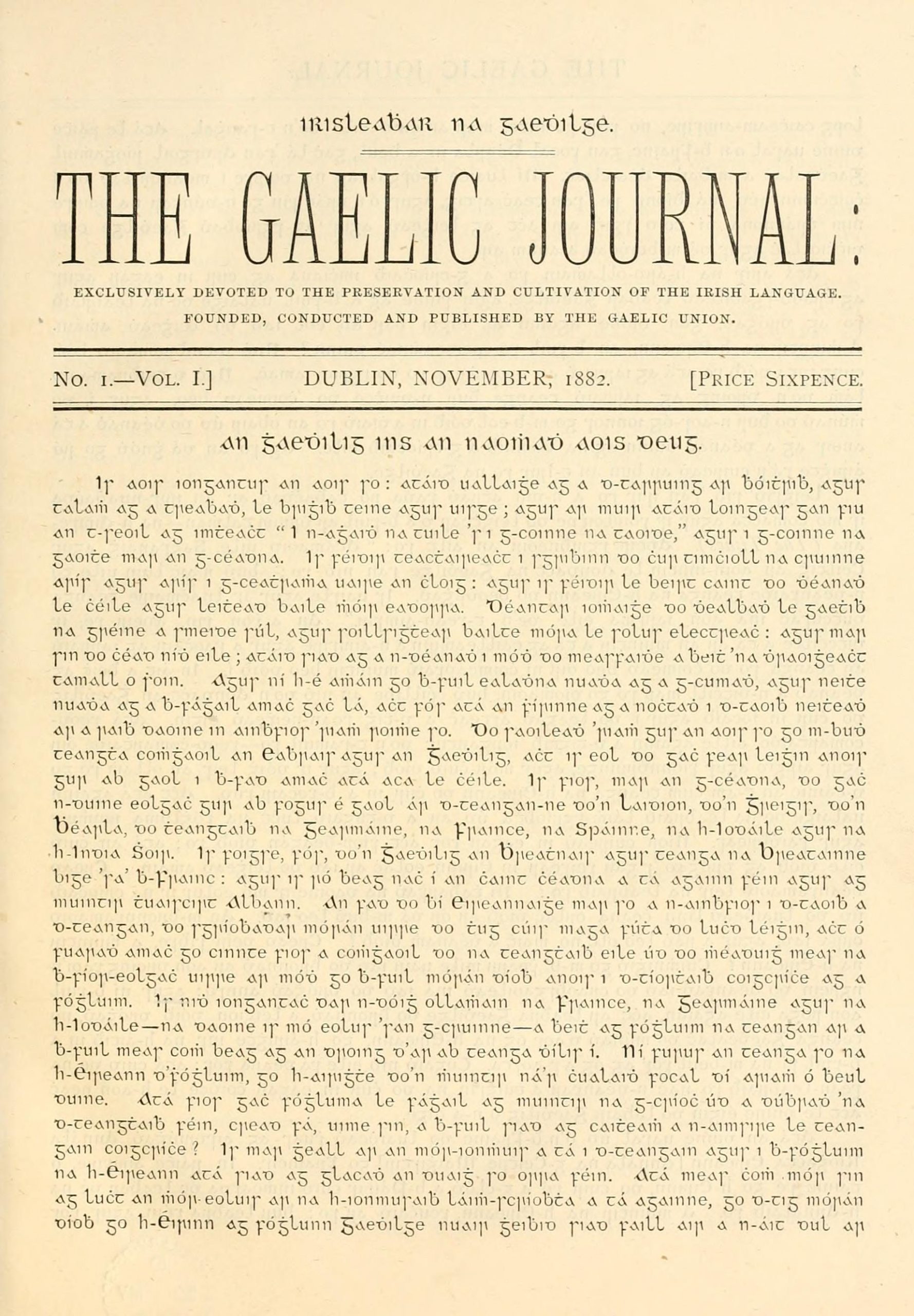
Edition of The Gaelic Journal published in 1882, part of the “Gaelic Revival.”
Author Bio
Will Falk is a writer, lawyer, and environmental activist. The natural world speaks and Will’s work is how he listens. He believes the ongoing destruction of the natural world is the most pressing issue confronting us today. For Will, writing is a tool to be used in resistance.
Will graduated from the University of Wisconsin-Madison Law School and practiced as a public defender in Kenosha, WI. He left the public defender office to pursue frontline environmental activism. So far, activism has taken him to the Unist’ot’en Camp – an indigenous cultural center and pipeline blockade on unceded Wet’suwet’en territory in so-called British Columbia, Canada, to a construction blockade on Mauna Kea in Hawai’i, and to endangered pinyon-juniper forests in the Great Basin.
His writing has been published by CounterPunch, Earth Island Journal, CATALYST Magazine, Whole Terrain, Dark Mountain Project, the San Diego Free Press, and Deep Green Resistance News Service among others. His first book How Dams Fall: Stories the Colorado River Told Me was published in August, 2019 by Homebound Publications.
He lives in Castle Rock, Colorado.
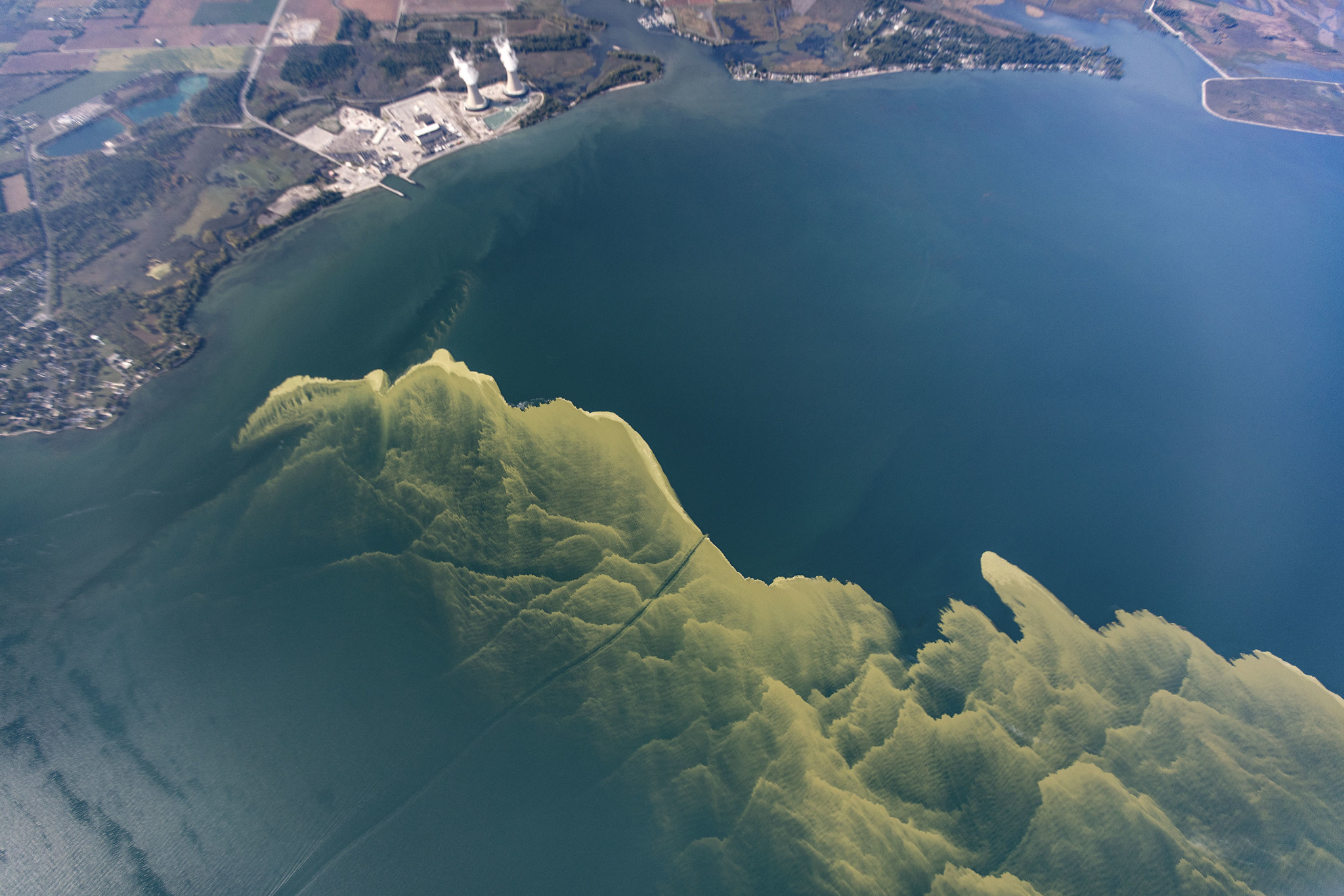
by DGR News Service | Jan 22, 2020 | Direct Action
By Will Falk
Featured image: Harmful algae blooms in Lake Erie in 2017. Public domain photo via NASA.
On Tuesday, January 28, at 10 AM, a hearing will be held in the United States District Courthouse in Toledo, OH in the case Drewes Farms Partnership v. City of Toledo. At stake in this case is the constitutionality of the Lake Erie Bill of Rights. It is possible – likely, even – that the Lake Erie Bill of Rights (LEBOR), democratically enacted by the people of Toledo, will be struck down by United States District Judge Jack Zouhary at this hearing.
If Zouhary strikes LEBOR down, he will do so despite a clear expression of the people of Toledo’s political will. LEBOR, after all was enacted with a 61% majority of the 15,000 Toledoans who voted on it. If Zouhary strikes LEBOR down, he will do so despite the ongoing harm current industrial and agricultural processes are causing to Lake Erie and all those who depend on Lake Erie’s water. If Zouhary strikes LEBOR down, he will do so despite the intensifying danger that once again a toxic algae bloom will get so bad that hundreds of thousands of Toledoans will be left without drinking water. And, perhaps the worst if of all, if Zouhary strikes LEBOR down, all those who worked so hard to see LEBOR enacted will be tempted to despair, to give up.
Do not despair. Do not give up. LEBOR represents only one of many tactics that can be used to protect Lake Erie.
To date, we have only employed indirect methods for protecting Lake Erie. We have asked the government and the courts to protect Lake Erie and they have consistently refused to do so. We have asked Zouhary to validate a democratically enacted local law. Hell, we asked Zouhary for permission to simply argue on Lake Erie’s and LEBOR’s behalf in Drewes Farms Partnership v. City of Toledo and he wouldn’t even grant us that. It is time we stop asking. It is time we stop using merely persuasive means for change. It is time we act directly to protect Lake Erie.
What would it mean to “act directly” to protect Lake Erie? The term “direct action” has been used so often in environmental and social movements in so many different contexts that it is in danger of losing its meaning. It is difficult to locate a clear definition of direct action in activist or academic literature rooted in a radical analysis, so I have formed my own. My definition has three parts: First, direct action involves a clearly-defined and obtainable goal. Second, the success of that goal is demonstrable by a quantifiable reduction in the opposition’s physical power. Third, it is primarily the actions of those engaging in the direct action that produce the desired goal.
It is important that a proposed action begins with a clearly-defined and obtainable goal because an action involving a poorly-defined goal makes it difficult to determine the scope of the action. And, proposed actions with unobtainable goals will be, by definition, ineffective. Planning to change the world through an educational program designed to illustrate the evils of the fossil fuel industry, for example, is neither clearly-defined nor obtainable. What does it mean “to change the world?” And, how will you possibly reach enough people to effect this change? Planning to disable a factory farm producing manure runoff into the Lake Erie watershed, however, is both clearly-defined and obtainable. Direct actionists can, without too much imagination, envision a successful action.
Once a clearly-defined and obtainable goal is established, the direct action must be designed to materially affect the opposition’s physical power. Let’s say activists come up with a plan to drop a banner that says “Rights for Lake Erie!” from the rafters of the Ohio State Capitol Building. The plan is both clearly-defined, and with some clever security dodging, obtainable. This action, however, is not direct action because there is no way to quantify how, or even if, the banner affects Lake Erie’s polluters ability to pollute.
Let’s consider another hypothetical plan: Activists plan to blockade trucks transporting manure through northern Ohio where the manure will be spread on farms. And, they plan to blockade these trucks for 24 hours. This plan has a clearly-defined and obtainable goal. The goal also reflects an understanding of power. Trucks transporting manure is one of the primary methods agricultural corporations use to pollute. Depriving these corporations of their manure for one day may not be a big hit to corporate power, but it is quantifiable.
It is primarily the actions of those engaging in the direct action that produce the desired goal. Another way to say this is: There is a clear causal link between the direct action and the desired goal. If the goal is to restrict the movement of trucks transporting manure, for example, then the planned action must literally restrict the trucks. Yet another way to say this is: direct action does not leave it to external decision-makers (governmental, judicial, or otherwise) to produce the desired goal. Direct action is not an appeal to those in power. It does not rely solely on moral persuasion, shame, or economic cost-benefit analyses.

This chart, excerpted from the book “Deep Green Resistance,” shows a taxonomy of action: a broad classification of different types of resistance actions that can be taken, including various types of direct action.
Viewed through this lens, the efforts to enact LEBOR, while heroic, are not direct action. LEBOR was a response to the toxic algae bloom that occurred in August, 2014 and left 500,000 Toledoans without drinking water during the hottest time of year. Toxic algae blooms, which have become a regular occurrence in Lake Erie, are primarily fed by agricultural runoff and are exacerbated by climate change. To stop the algae blooms requires stopping the agricultural runoff. In order for citizens to use LEBOR to stop agricultural runoff, first requires the federal courts to rule that LEBOR is constitutional and valid. Not only do we need Zouhary to rule in favor of LEBOR, but, if Zouhary rules in favor of LEBOR, it’s likely that Drewes Farms Partnership and the State of Ohio would appeal Zouhary’s decision to the Sixth Circuit. Then, if the Sixth Circuit ruled in favor of LEBOR, Drewes Farms Partnership and the State of Ohio, would likely appeal to the Supreme Court.
So, before we could ever use LEBOR to bring actions against agricultural polluters for violating Lake Erie’s rights, we’d have to convince three different courts to uphold LEBOR. Even if we succeeded in convincing each level of the federal courts to rule in favor of LEBOR, we would then, in each case brought against agricultural polluters under LEBOR, need to convince a judge that the actions of agricultural polluters violate Lake Erie’s rights. In other words, LEBOR is not direct action because it relies on external decision makers – the courts – to produce the desired goal.
I am not in any way suggesting that the tremendous efforts Toledoans have put into LEBOR have been a waste. They have not been. The efforts to enact LEBOR placed the question of rights of nature before the people of Toledo and secured a clear, democratic expression that the people of Toledo do, in fact, support rights of nature. This strengthens the moral superiority of our claims. Not only are we justified in stopping agricultural polluters because they are poisoning Toledo’s drinking water, we are justified because the majority of the community believes Lake Erie should have rights to be free from this pollution.
In many ways, it would be easier if we could convince the courts to uphold Lake Erie’s rights. If the courts recognized LEBOR, we could sue polluters. And, in those lawsuits, after finding that the polluters have violated Lake Erie’s rights, judges could order armed men and women (the police) to force polluters to stop polluting. The important thing to recognize though is that the police do not own a monopoly on power. We have the power to stop polluters from polluting, too. Factory farms can be occupied. Access to manure can be limited. The capacity to distribute manure can be impaired.
It is true that those who effectively engage in direct action to protect Lake Erie will place themselves in danger. It is possible that direct actionists will be arrested, that the police will respond violently, and that the media and members of the public will criticize and ostracize us. But the truth is violence is already being used against us. Poisoning a city’s drinking water is violence. And, if we don’t succeed in stopping this poisoning, more nonhumans will be murdered, more humans (especially the most vulnerable among us such as children and the elderly) will get sick and may even die, too. If we don’t succeed in stopping this poisoning, in other words, the violence will only intensify.
Fear in the face of these dangers is understandable. The question is: How do we overcome the fear? Bravery is a personal thing. It is something each individual must find for her or himself. No one can find it for you.
Personally, I find my courage on Lake Erie’s shore. I find it witnessing the sick, pale bellies of dead perch floating through the thick, green scum that forms on Lake Erie’s surface and suffocates fish every summer. I find it in the scent of the rotting corpses of dogs, deer, foxes, gulls, eagles, herons, and the many other animals who drink and feed from Lake Erie. I find it in the looks on the faces of children who arrive cheerfully on Lake Erie’s beaches in the heat of summer only to find the lake is too dangerous to swim in. I find it in the rashes that form on the skin of children who were unaware of the danger toxic algae blooms pose. I find it in the vomit of those unlucky enough to unknowingly drink toxic Lake Erie water. I find it when I read studies about the cancer, Alzheimer’s disease, and other illnesses toxic algae blooms cause. I find it when I remember that only a few short centuries ago, indigenous peoples bathed on Lake Erie’s shores, celebrated the deliciousness of Lake Erie’s fish, and drank freely of Lake Erie’s waters with no inkling of the destruction to come.
I find my courage when I realize that all of this is only going to get worse if we don’t act, directly and decisively, to protect Lake Erie’s life-giving water.
Will Falk is a writer, lawyer, and environmental activist. The natural world speaks and Will’s work is how he listens. He believes the ongoing destruction of the natural world is the most pressing issue confronting us today. For Will, writing is a tool to be used in resistance.
Will graduated from the University of Wisconsin-Madison Law School and practiced as a public defender in Kenosha, WI. He left the public defender office to pursue frontline environmental activism. So far, activism has taken him to the Unist’ot’en Camp – an indigenous cultural center and pipeline blockade on unceded Wet’suwet’en territory in so-called British Columbia, Canada, to a construction blockade on Mauna Kea in Hawai’i, and to endangered pinyon-juniper forests in the Great Basin.
His writing has been published by CounterPunch, Earth Island Journal, CATALYST Magazine, Whole Terrain, Dark Mountain Project, the San Diego Free Press, and Deep Green Resistance News Service among others. His first book How Dams Fall: Stories the Colorado River Told Me was published in August, 2019 by Homebound Publications.
http://willfalk.org/

by DGR News Service | Dec 20, 2019 | Agriculture, Biodiversity & Habitat Destruction, Human Supremacy, Toxification
by Sean Butler and Will Falk / Featured image: an aerial photograph showing harmful algae blooms in Lake Erie in August of 2017. These are believed to be caused by the effluent runoff from factory farms in the watershed. Public domain photo by NOAA.
Rights of nature advocates often repeat the words, “The structure of the legal system makes meaningful environmental protection illegal.” It’s a bold claim, but for most people it’s too vague to mean anything. Most folks (understandably) don’t know the difference between a federal district court and a circuit court of appeals, let alone what we mean by the “structure” of the legal system.
But it’s actually quite simple. We’re referring to two aspects of the American legal system: (1) laws and regulations at the federal, state, and local (city and county) levels and the relative hierarchy among them; and (2) the holdings of various state and federal courts throughout the history of our country, which establish “precedent” for what those laws and regulations actually mean.
Perhaps nowhere in recent memory has the “structure of the legal system” been laid bare more clearly than in the aftermath of the passage of the Lake Erie Bill of Rights by the citizens of Toledo, OH in February 2019. The Lake Erie Bill of Rights (LEBOR) grants Lake Erie the rights to exist, flourish, and naturally evolve; grants the residents of Toledo a right to a healthy environment; and “elevates the rights of the community and its natural environment over powers claimed by certain corporations.”
Although remarkable on its face, LEBOR is only one of dozens of similar local laws that have been passed in recent years in cities and counties across the United States. What is truly remarkable is the response LEBOR has received from existing institutions.
Mere hours after the City of Toledo certified LEBOR’s election results, entrenched interests opposed to environmental protection leveraged the existing structure of American law to mount an urgent opposition to LEBOR. Drewes Farms Partnership (“Drewes Farms”), represented by a corporate law firm, sued the City seeking an injunction against enforcing the law on the basis that LEBOR violates Drewes Farms’ “civil rights.” The State of Ohio was allowed to intervene in the case to argue for LEBOR’s invalidation while the grassroots community group, Toledoans for Safe Water – who drafted LEBOR and ushered it through Ohio’s citizen initiative process — was barred from the case by the federal judge. Then, the Ohio State legislature (at the request of the Ohio Chamber of Commerce) included in its 2019 budget a provision explicitly making it illegal for local governments to make or enforce laws ascribing legal rights to nature.
In short, the existing legal system and those who profit from it brought the full weight of the legal system against LEBOR. To really understand what is meant when we say that the structure of the legal system makes meaningful environmental protection illegal we need to dig into the specifics of this onslaught.
LEBOR’s opponents make primarily two legal arguments against it. First, they claim that LEBOR should be invalidated because it infringes on corporate constitutional rights. Second, they argue that LEBOR is preempted by state and federal law that reserves the right of the state of Ohio and the federal government to legislate on environmental matters.
Drewes Farms makes the corporate constitutional rights argument very clearly in the complaint it filed in federal court, claiming that:
“LEBOR causes real and concrete harms on Drewes Farms by violating the United States Constitution including but not limited to:
- Depriving Drewes Farms of its fundamental right to freedom of speech and to petition the courts under the First Amendment;
- Violating Drewes Farms’ right to equal protection by targeting it for liability based solely on the fact that it operates as a partnership business entity;
- Violating the Fifth Amendment protection against vague laws by exposing Drewes Farms to strict criminal liability and massive damages and fines under a standardless Charter Amendment; and
- Depriving Drewes Farms of its rights without due process.”
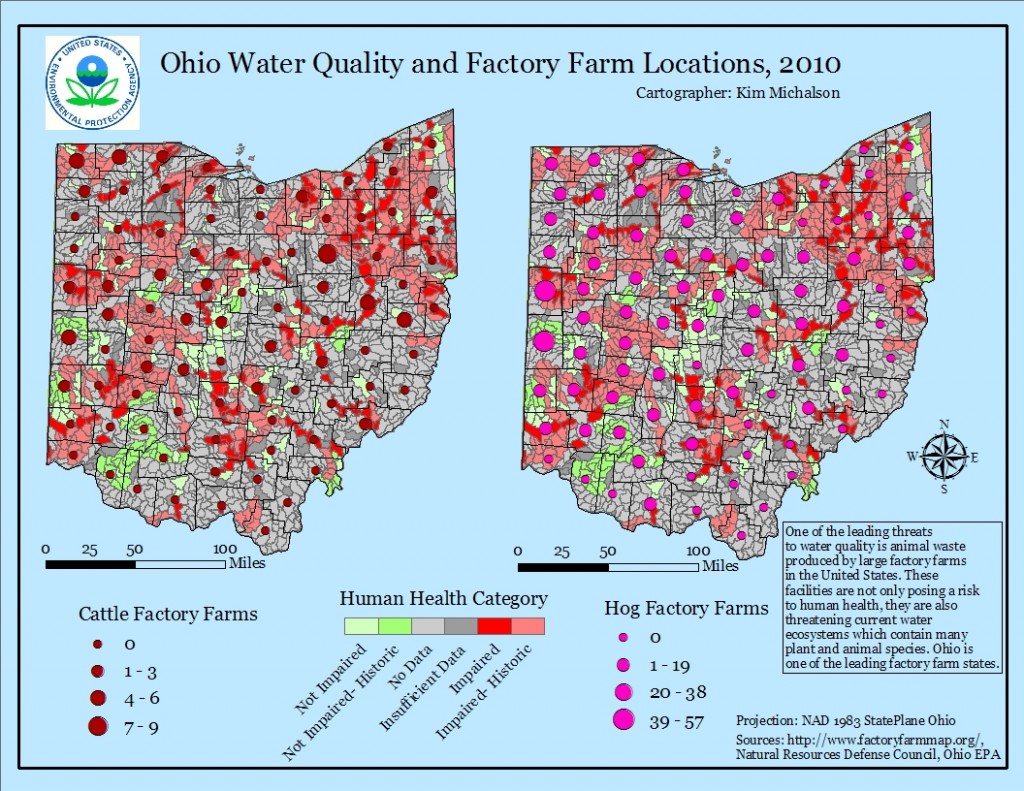
This 2010 map shows the location of major factory farming operations in Ohio and corresponding water quality readings. Ohio has among the highest density of CAFOs (Concentrated Animal Feeding Operations) of any U.S. state. Map by Kim Michalson.
Just so we’re clear, Drewes Farms, a non-human legal entity, lays claim to rights under the First, Fifth, and Fourteenth Amendments to the US Constitution AND claims that those rights are violated by a law that recognizes nature’s right to exist, flourish, and naturally evolve.
Meanwhile, the State of Ohio, in its Complaint for Declaratory Judgment and Injunctive Relief plainly states that “[t]he Ohio Constitution art. XVIII § 3 does not allow a municipality to enact an ordinance that prohibits regulated activity authorized under state permits issued pursuant to state laws of general applicability.” To support its claim, the State cited a recent Ohio case in which the judge ruled “[s]tate laws with state-wide application preempt local ordinances that discriminate, unfairly impede, or obstruct general laws regulating oil and gas activities.” In other words, the Ohio state constitution itself specifically prohibits any local government to enact laws that prohibit activities that are permitted by state laws.
The fundamental issue with both of these arguments is…they are absolutely, totally, and completely right. Under current American jurisprudence, Drewes Farms does have civil rights under the First, Fifth, and Fourteenth Amendments (among others), and LEBOR does violate principles of preemption.
And that is precisely the problem.
Because American law has long recognized corporate civil rights and has long used preemption to invalidate local laws that provide for stricter regulations than federal or state governments, the State of Ohio and Drewes Farms would have us believe that this should be the end of the discussion. But, ending the discussion here leaves several problematic assumptions unchallenged. Arguing that LEBOR should be invalidated because it infringes on corporate rights only makes sense if corporations should enjoy those rights under our system of law. And arguing that LEBOR should never be enforced because it violates established principles of preemption only makes sense if preemption is beneficial to American citizens.
So, we must dig deeper. We must ask: Why do corporations exist? What are corporate rights? Why does the American legal system afford corporations rights in the first place? We must also ask: Why does preemption exist? Why does the American legal system protect the state and federal governments’ power to preempt laws passed by local communities? And, is there a connection between growing corporate power and preemption?
While there is a debate about what corporations should exist to do, the fact remains that corporations exist to amass wealth, or to borrow one of corporate apologists’ favorite phrases, to “maximize shareholder value.” We can see this argument clearly in the hugely influential essay published in 1970 by the Nobel Prize-winning economist Milton Friedman in The New York Times Magazine aptly-titled “The Social Responsibility of Business is to Increase its Profits.” Environmental author and philosopher Derrick Jensen, in The Culture of Make Believe, is more direct:
“To expect corporations to function differently than they do is to engage in magical thinking. We may as well expect a clock to cook, a car to give birth, or a gun to plant flowers. The specific and explicit function of for-profit corporations is to amass wealth. The function is not to guarantee that children are raised in environments free of toxic chemicals, nor to respect the autonomy or existence of indigenous peoples, nor to protect the vocational or personal integrity of workers, nor to design safe modes of transportation, nor to support life on this planet. Nor is the function to serve communities. It never has been and never will be.”
Wealth is power. This is especially true in the legal system. Many people envision law as an all-powerful list of rules that dictates what someone can or cannot do. Similarly, many people think of rights as a list of privileges that specify what a person is entitled to do or entitled to be free from. As such, many people imagine that they can simply invoke these rights to be safe. But, it is a mistake to think that rules written somewhere in a book of statutes or rights listed in the Constitution have the power to jump off the paper where they are written and enforce themselves.
The key to understanding law and rights lies in understanding how they are enforced. Judges enforce law and rights by making decisions in court. And those decisions in court, in turn, are enforced by the police who are entitled to use physical force to ensure a judge’s decision is adhered to. When most people think about how this works, they envision examples such as President Eisenhower’s use of the National Guard to desegregate schools to uphold African Americans’ Fourteenth Amendment rights. But, a more apt and contemporary example is reflected in how the police were used at Standing Rock. Dogs, water cannons, and military-style weapons were turned against nonviolent protesters once the owner of the pipeline project, a corporation, won a favorable court ruling. These corporate rights-holders harnessed the state’s police power through the courts.

A typical “animal waste lagoon.” These containment ponds continuously leach into groundwater, and often overflow. Public domain photo by NRCS.
Rights, then, are power, too. When shareholders form a corporation, the corporation gains the privilege of “corporate personhood.” Because American courts treat corporations as “persons,” corporations have long exercised rights, including those afforded the highest level of protection under the Bill of Rights’ Contracts Clause, Due Process Clause, Fourteenth Amendment Equal Protection Clause, First Amendment, Fourth Amendment, Fifth Amendment Takings and Double Jeopardy Clauses, Sixth Amendment, and Seventh Amendment.
These rights have, for the most part, been judicially created and have consistently expanded throughout American history. The word “corporation” is found nowhere in the Constitution. Despite this, in 1819, in Dartmouth College v. Woodward, the U.S. Supreme Court ruled that the Contract Clause of the Constitution granted private business corporations protection from governmental interference in internal governance. In 1886, in Santa Clara County v. Southern Pacific Railroad Company, the Supreme Court ruled that a corporation is a person under the law and is therefore entitled to equal protection under the Fourteenth Amendment. In 1922, the Supreme Court ruled in Pennsylvania Coal Company v. Mahon, that coal corporations were entitled to protection under the Fifth Amendment “Takings Clause” and that the government must compensate corporations for property value lost due to mining regulations. In 2010, the Supreme Court ruled that federal laws which limited corporate spending in elections violated corporate First Amendment “free speech” rights in Citizens United v. Federal Elections Committee. Then, in 2014, the Supreme Court, in Burwell v. Hobby Lobby Stores, allowed corporations to deny its employees health coverage of contraception to which the employees would otherwise be entitled because corporations are entitled to First Amendment freedom of religion protection.
This might not seem problematic on its face, but recall that rights only have practical effect to the extent that rights holders can access the courts in order to ask a judge to enforce those rights. Corporations, that exist to, and have grown quite adept at, amassing wealth, have greater means to put behind the legal enforcement of rights. This naturally means more cases won by corporate plaintiffs, more caselaw upholding corporate rights, and therefore, by extension, more caselaw expanding the sphere of corporate civil rights. And the sheer number of cases bear out this reality. As an example, consider this: between 1868, when the Fourteenth Amendment was ratified, and 1912, the Supreme Court ruled on only 28 cases involving the rights of African Americans and an astonishing 312 cases on the rights of corporations, it is easy to conclude that the Fourteenth Amendment has done a better job protecting the rights of corporations than that of African Americans.
At the same time, the expansion of rights in one sphere necessarily produces the curtailing of rights in another. Deep ecologist John Livingston describes the problem:
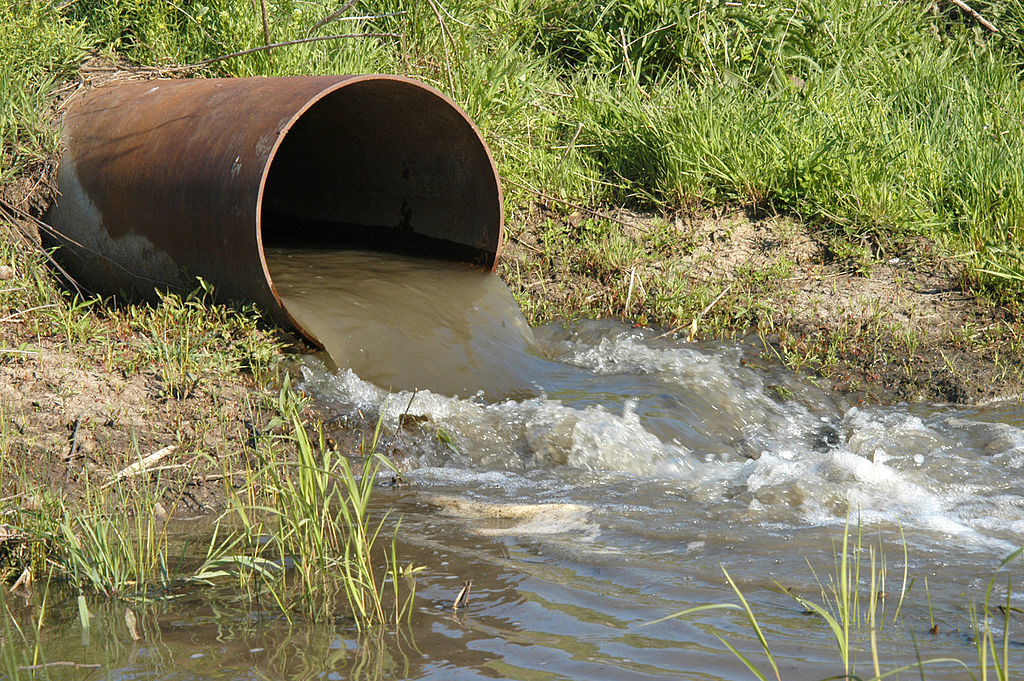
Effluent discharge pipe. Public domain image from USDA.
“We sometimes forget that every time a court or legislature – or even custom – confers or confirms a right in someone, someone else’s right is nibbled at: the right of women to equal employment opportunity is an infringement of the freedom of the misogynist employer; the right to make a profit is at someone else’s cost; the right to run a motorcycle or a snowmobile reduces someone else’s right to peace and quiet in his own backyard; the rights of embryos impinge upon the rights of the women who carry them. And so on.”
In other words, the expansion of corporate rights shrinks the rights enjoyed by citizens and communities. Because American law extends to corporations many of the same constitutional rights humans enjoy and because corporations exist to accumulate wealth, we should not be surprised when corporations use their power to do exactly that at the expense of the rights of human beings and nature.
The other major legal argument made against LEBOR is that it is preempted by state and federal law. Preemption is a doctrine that says the law of a higher jurisdiction should displace the law of a lower jurisdiction when the two jurisdictions conflict. The American legal system is divided basically into three jurisdictions: federal, state, and local law (local law is a general term for the law of the smallest legislating entities American law allows, entities such as municipalities, cities, or villages). When federal and state law conflict, American courts interpret the Supremacy Clause of the United States Constitution (Article VI, Section 2) to mean that federal law should displace state law. Similarly, state law usually trumps local law when the two conflict.
Corporations, using their superior wealth and their constitutional rights, have found tremendous success in influencing federal and state legislatures, especially pro-business, conservative legislatures and persuading them to enact aggressive new preemption laws. When local governments pass laws with stricter restrictions than the federal or state legislatures, corporations lobby legislatures to employ preemption to attack these local laws. This typically happens in one of two ways. First, government lawyers, primarily attorneys general, assert the doctrine of preemption in court. The State of Ohio’s arguments against LEBOR are a perfect example. Second, legislatures pass legislation known as “blanket” preemption to expressly forbid local ordinances that contradict state law. And, in fact, the Ohio House of Representatives recently employed blanket preemption when it adopted its 2020-2021 budget with provisions that prohibit anyone, including local governments, from enforcing rights of nature laws.
That’s what preemption is. The more important question is: Why does American law protect the federal and state governments’ power to preempt laws passed by local communities? The answer, quite simply, is corporate power.
The modern preemption doctrine was born from an 1868 decision written by Iowa Supreme Court Chief Justice John Dillon in The City of Clinton v. The Cedar Rapids and Missouri River Railroad Company. The case involved an attempt by the people of Clinton, Iowa to prevent railroad corporations from building railroads through their town. An ordinance was passed by the Clinton city council which prohibited any “railroad company from constructing its track through or upon any street within the limits of the city, and from occupying the same for right of way or other railroad purposes.”
In the decision, Dillon struck down Clinton’s ordinance and described his philosophy of the limited powers of municipal corporations and other local governing entities. This philosophy is now known as “Dillon’s Rule.” He wrote:
Municipal corporations owe their origin to, and derive their powers and rights wholly from, the legislature. It breathes into them the breath of life, without which they cannot exist. As it creates, so it may destroy. If it may destroy, it may abridge and control. Unless there is some constitutional limitation on the right, the legislature might, by a single act, if we can suppose it capable of so great a folly and so great a wrong, sweep from existence all of the municipal corporations in the State, and the corporation could not prevent it. We know of no limitation on this right so far as the corporations themselves are concerned. They are, so to phrase it, the mere tenants at will of the legislature. 24 Iowa 455, 475.
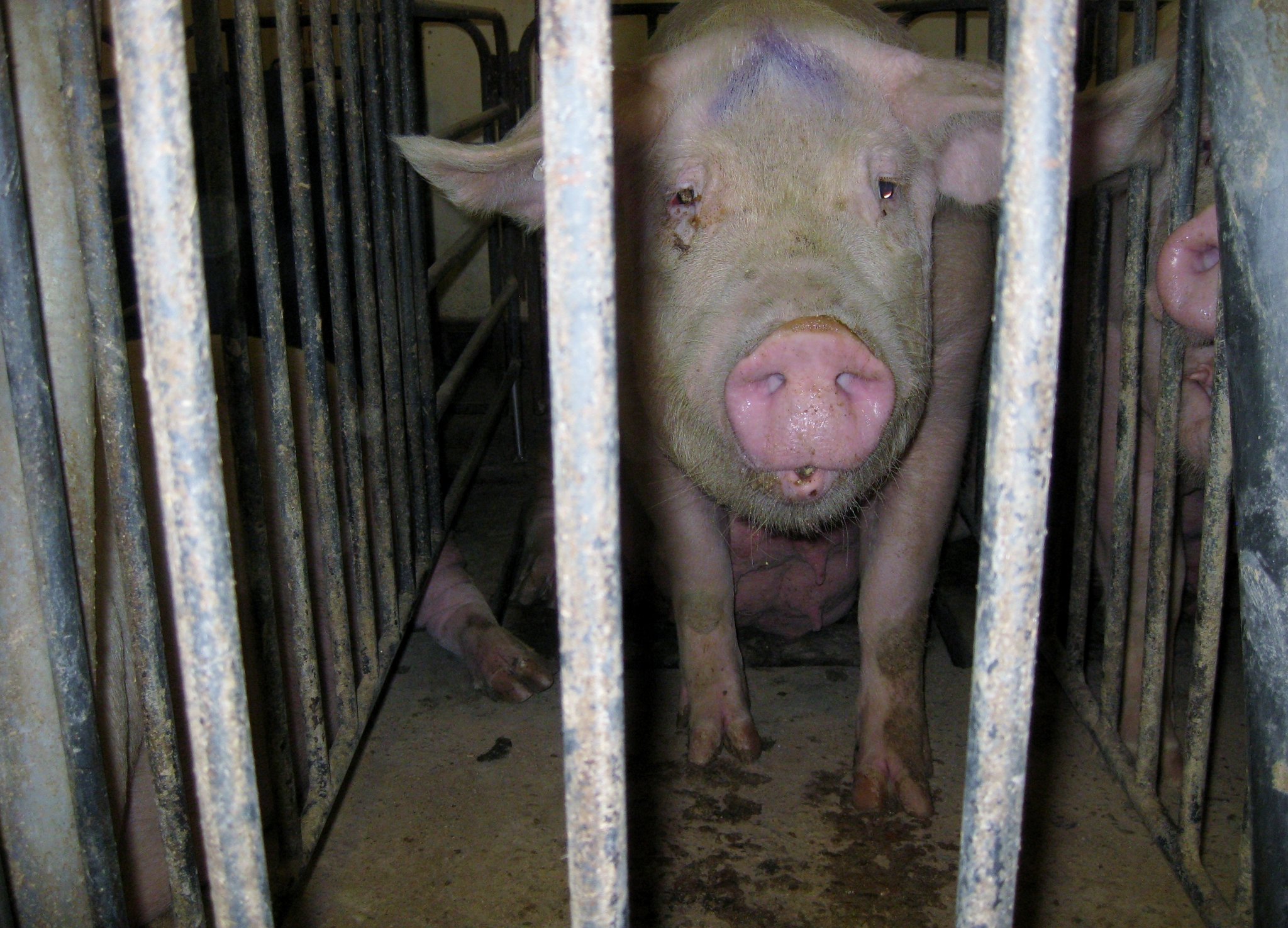
A pig at a factory farming operation. These industrial farms are the largest source of nutrient pollution in Lake Erie. https://creativecommons.org/licenses/by/2.0/ Via Mercy for Animals.
And, Dillon’s Rule was later adopted by the United States Supreme Court in 1907 in Hunter v. Pittsburgh.
As you can see, from the outset, preemption has been, quite literally, about corporations “railroading” local communities who do oppose destructive corporate projects. Today, preemption has grown into a powerful tool wielded by, especially, conservative, pro-business state legislatures. Judge Jon D. Russell and Aaron Bostrom, in a white paper titled “Federalism, Dillon Rule and Home Rule” recently written for the American City County Exchange (an organization that “helps to advance limited government and free market principles in local government through model policies, conferences, and online collaboration”), provide a solid example of the rationale employed by state legislators to defend preempting local laws.
Russell and Bostrom write:
The Dillon Rule guarantees a certain level of uniformity throughout the state…Rather than having vastly different policies and codes in each local jurisdiction, the state can create uniform tax codes and licensing policies, making it a business-friendly environment. Without commonality between local governments on these issues, businesses find more red tape than opportunity, making it difficult for the state and businesses to prosper.
Dr. Lori Riverstone-Newell, an expert in the interaction of governments in the American system, describes how in the past few years, “a growing number of state officials have sponsored and supported preemption legislation with the intent to weaken local authority and to thwart local progressive policies.” In simpler terms, conservative state legislators are learning how to use preemption to prevent progressive communities from enacting progressive laws.
We can see why some commentators argue we live in a corporate state. If the fundamental element of a democracy is the right of the people to enact and enforce the laws to which they are subject, then preemption is fundamentally an anti-democratic concept, especially as the doctrine has been influenced and wielded by entrenched economic interests and the state and federal legislators who support (and who are, of course, supported by) those interests.
Indeed legislators are not working alone; they are implementing policies pushed by corporate lobbyists. Dr. Riverstone-Newell explains, “Recent preemption efforts can be understood, at one level, as part of longstanding campaigns waged by industry groups hoping to stop or limit progressive local policies in order to create a friendlier business environment for themselves.” She describes how industry groups and trade associations first began pressuring state legislatures to rein in their cities in the late 1980s. R.J. Reynolds, the tobacco corporation, “pressed states to enact preemption laws in the 1980s as a central strategy to overcome local smoking restrictions and bans.” Abby Rapoport, a journalist writing for The American Prospect, reports how the National Rifle Association launched a campaign in the 1990s for state preemption of local gun regulations. This campaign was so successful “43 states now have some form of maximum preemption preventing localities from passing additional gun regulations on top of state law.”
It may very well be that “a certain level of uniformity” of laws in different jurisdictions enables business to “prosper,” but having reached the point in our nation’s history where we are confronting ecological collapse, we have to ask ourselves, whether blanket uniformity and unchecked economic growth and prosperity are the only values that matter to us. Or, instead, might it be that local environmental protection laws are key to protecting local ecology? Might it be that the unique ecosystems in one ‘jurisdiction’ require unique laws and regulations in order for them to thrive? Why should we expect that laws protecting swamplands in Florida be the same as those protecting the Nevada desert? If we are to see our way through the current environmental crisis, we can’t simply accept the doctrine of preemption on its face; we must consider the value of it, and its history and development, in order to determine whether or not it is compatible with the future we want for our grandchildren and the planet.
The failure to recognize how American law makes sustainability illegal is a primary reason environmentalists have failed to keep the health of the North American continent from deteriorating over the last century. Because we fail to recognize this, we keep seeking to protect the natural world through legal and political processes that do not – cannot – work. The late corporate anthropologist Jane Anne Morris described our predicament clairvoyantly:

Lake Erie (left) is the 11th largest lake in the world. Public domain NASA photo.
“Our campaigns follow the gambling addiction model. The last bet didn’t pay off but the next one might if…if…if we just had a new, improved tripod, three more experts, more labor or church support, ten more elected officials on our side, a hundred more people at the demo, or a thousand more letters in the mail…Who are we kidding? We are just doing the ‘same old thing’ over and over again and fooling ourselves that it might work next time. We are stuck in a feedback loop where our failures are interpreted as signs that we should repeat our failed tactics, but try harder. This is what it is to be colonized.”
Lawyers, and their clients, are especially vulnerable to falling victim to Morris’ gambling addiction model. The adversarial, competitive nature of law where two or more sides jockey for the approval of a judge makes it easy for losing parties to conclude that if they just hired a more expensive law firm, or if they just argued an issue differently, or if they just cited this case instead of that case then they would have won. The problem, however, is not that we need to try harder; the problem is that the structure of American law prevents our ability to implement strong enough measures to truly protect the natural world.
The people of the City of Toledo, recognizing that corporate rights and preemption must be confronted and overturned to protect Lake Erie and all those who depend on her, voted to enact the Lake Erie Bill of Rights. The arguments made by the State of Ohio and Drewes Farms Partnership are currently the law en vogue. This is one of the major reasons American law makes sustainability illegal. This must change if the natural world, and all of us who depend on her, are going to survive the current ecological predicament. To achieve a sane, sustainable culture, corporate rights and preemption must go.
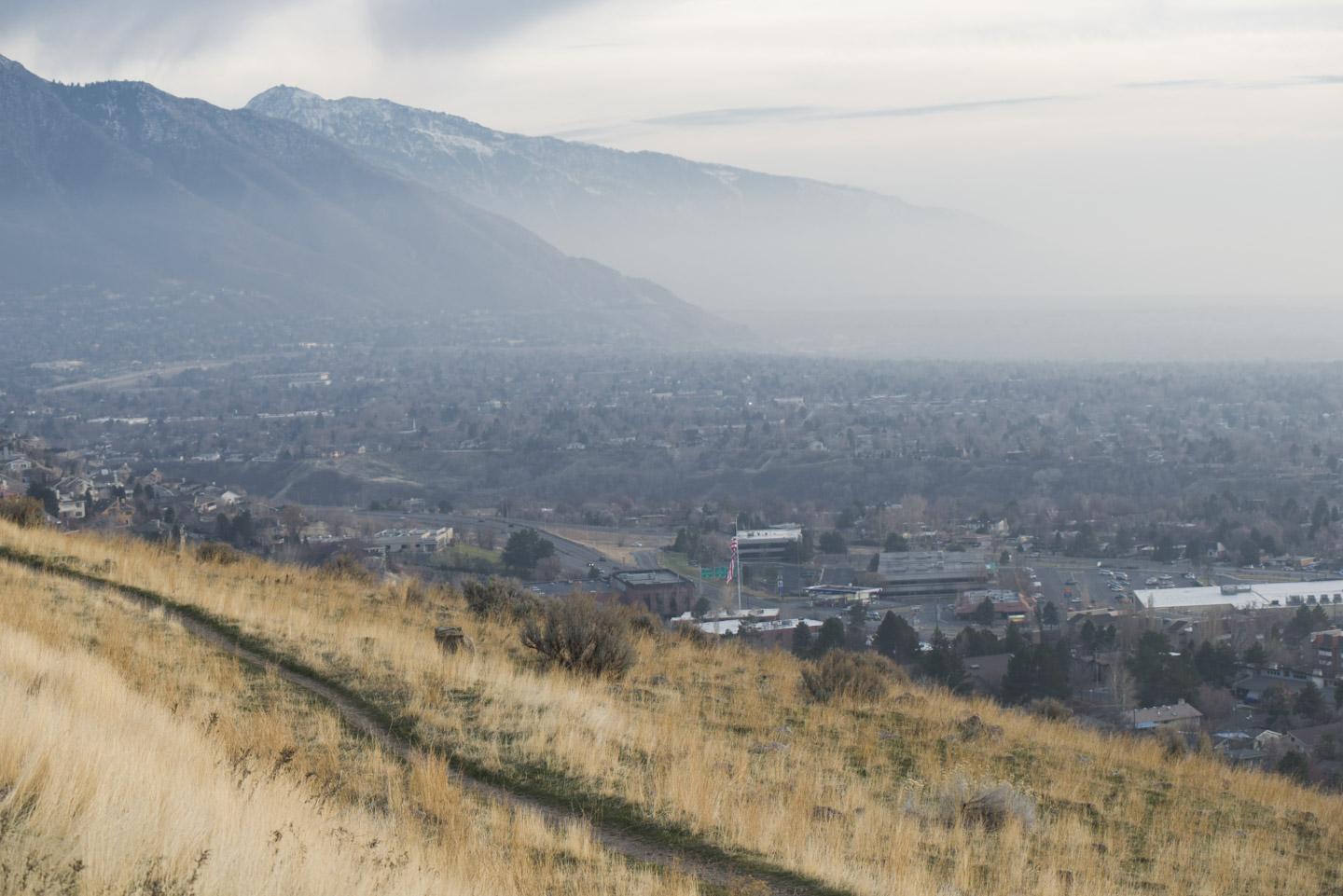
by DGR News Service | Sep 30, 2019 | Listening to the Land
By Will Falk / Originally published in Canary Literary Magazine
Featured image: “Smog, Salt Lake Valley, and Wasatch Mountains” by Max Wilbert, CC BY-NC-SA 4.0
I want to give up. Each morning the headlines are heavier and my heart buckles under the load. A United Nations report, prepared by 145 experts from 50 countries, warns that one million of the planet’s eight million species are threatened with extinction by humans. This comes after a recent report by the Living Planet Index and the World Wildlife Fund which reveals that, since 1970, 60 percent of all vertebrate wildlife has been destroyed. The outlook is grim for invertebrate wildlife, too. Groundbreaking research describes how flying insect populations fell by 75 percent in just 27 years in Germany, prompting scientists to declare: “The insect apocalypse is here.”
The bad news globally reflects my bad news personally. I am an environmental lawyer. I became a lawyer because I saw law as a tool to wield in the service of life. I’ve devoted my career to protecting what’s left of the natural world.
It isn’t working.
Not long ago, I helped to file the first-ever federal lawsuit seeking rights of nature for a major ecosystem, the Colorado River. Despite the fact that nearly 40 million humans and countless non-humans depend on the Colorado River for fresh water, the Colorado River is one of the most abused rivers in the world. We filed the lawsuit hoping to gain meaningful protections for the river as a major source of life in the region. In response, the Colorado Attorney General threatened us with financial and ethical sanctions if we didn’t withdraw the lawsuit because our argument that the Colorado River should have similar rights to those possessed by the corporations destroying her was, according to the AG, “frivolous.”
I’m currently involved in helping citizens of Toledo, Ohio, defend a rights of nature law for Lake Erie from attack by agricultural interests. The law, titled the Lake Erie Bill of Rights, was drafted by citizens of Toledo after their tap water was shut off in 2014 due to a poisonous harmful algae bloom. These blooms are fed by phosphorus in manure run-off primarily produced by corporate agricultural operations. The Lake Erie Bill of Rights, which was enacted through one of the most directly democratic processes available to American citizens – a citizen initiative process – was passed with 61 percent of the vote. Without regard to the clear expression of political will expressed by 61 percent of the Toledoans who voted for the law, the City of Toledo agreed to a court order preventing the City from enforcing the law. And, the grassroots organization who ushered the law through the initiative process has been denied the ability to intervene to argue on behalf of Lake Erie in both the federal district court and the Sixth Circuit Court of Appeals. The Lake Erie Bill of Rights, despite all the effort put into its passage, will, almost certainly, be invalidated without ever going into effect.
More and more, I realize the change we so badly need is unlikely to ever come through the legal system. Sure, we sometimes succeed in delaying destructive projects when corporations make a mistake in filing their permit applications. But they always correct the mistake and the destruction continues. Yes, we sometimes succeed in protecting an endangered species from the most direct threats to their survival. But we have not alleviated the global processes, like climate change and human overpopulation, that will likely spell endangered species’ long-term doom. True, we have brought a growing awareness of ecological collapse to the general public. But awareness is a primarily mental affair happening within human heads while environmental issues are physical problems happening in the real world and they require physical, not mental, solutions.
Despair pushes me into my backyard where a small voice within me, growing increasingly louder, tells me to give up. When the problems are so big and the vast majority of people simply don’t care, the voice demands, why are you struggling so hard to fight back?
The Wasatch Mountains, looming in the west above the Heber Valley where I live, help me keep that nagging voice at bay. Across most of the world, the horizon is boundless. When burdens are too much to bear, you may spill your consciousness across the landscape. You can let your mind run to that place, always pleasantly just out of reach, where land meets sky. You can let your thoughts slip down the perpetual curve of Mother Earth’s body where you can lose your anxieties in her vastness.
But, not in my backyard. The Wasatch Mountains hold my soul in place. They won’t let me hide. They stand high and proud, displaying their injuries. I never doubted, but the mountains pull my spirit like Thomas’ fingers into Christ’s wounds. Roads slice across the mountains’ shoulders. Swathes of forest, clear-cut by ski resorts for ski runs, are lacerations that stripe the backs of the flogged. Bare stone, where snow was snatched away by climate change, is flayed skin. In my backyard, to witness the Wasatch Mountains is to ache.
Mountains speak. To listen, you must be as the mountains are: patient, persistent, still. If you try, you might hear, as John Muir did, the mountains calling. They call on us to be strong, to stand proud and resolute, to resist environmental destruction like the mountains resist the roadbuilders, the clear-cutters, and the miners. They’re calling on us to resist ecocide like mountains resist the geologic forces trying to drag them down. We have suffered, the mountains explain. We will continue to suffer until this madness stops. Yet, still we rise.
As massive as they are, the mountains’ wounds are only a fraction of the planet’s. Yes, the bad news piles up. The horrors intensify. The voice urging me to quit amplifies. But, with the Wasatch Mountains’ help, until all of Earth’s festering wounds have healed and only scars remain, I will not quit. I will do as the mountains do. I will rise and fight.
![[The Ohio River Speaks] Headwaters: The Journey Begins](https://dgrnewsservice.org/wp-content/uploads/sites/18/2020/06/Headwaters-The-Journey-Begins.jpg)











